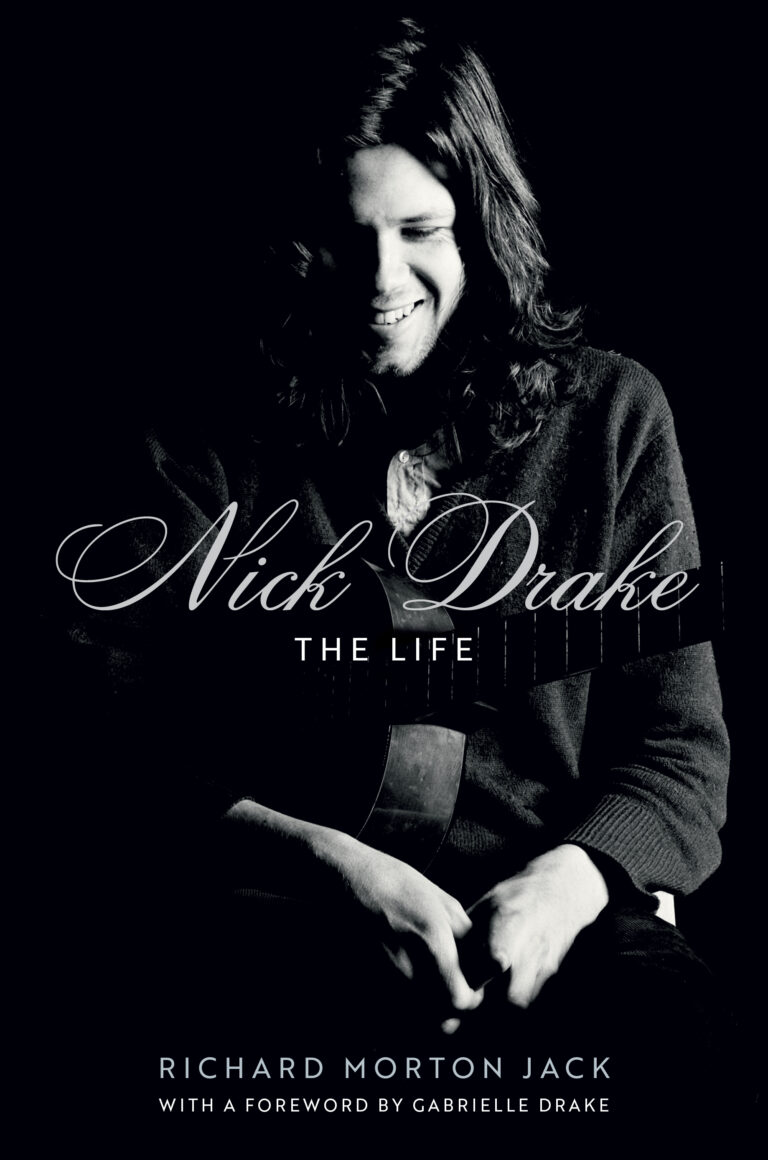

The life of the once ignored and now venerated Nick Drake is the subject of an enlightening new biography, one that gives new meaning to the term “definitive” – NICK DRAKE: The Life by Richard Morton Jack (Hachette Books).
Drake was the ultimate cult artist. He was the creator of three well-regarded and oft imitated albums which only achieved a significant mainstream impact a quarter century after his death, in large part due to the use of his tune, “Pink Moon,” in a 1999 ad campaign for Volkswagen.

Drake was the kind of artist who couldn’t exist today. He was one who chose not to perform live, or do interviews for that matter, a young college student who was given well over a year of studio time to create his brilliant but barely selling debut album. Nick’s reluctance to play the careering game wasn’t born of ego or snobbery. It was the result of an emotional illness that would deepen and ultimately swamp him over time, one that would lead to his death at age 26 due to an overdose of anti-depressants in 1974.
While not an officially sanctioned book, NICK DRAKE: The Life is the only biography written with the blessing, involvement and a mountain of material provided by his sister and estate. The author interviewed well over 200 of Drake’s friends, school mates, family and fellow musicians to chart his life and career. He also had full access to a deep archive of personal material unavailable to previous writers. This included volumes of correspondence by Nick, his family, friends and teachers – material that provides an almost day-by-day catalogue of his activities and frame of mind during his short and enigmatic life. An especially important one is the diary Nick’s father kept as they worked to help their son cope with the growing disappointments in his life and musical career, and the final chapter of his battles with the treacherous illness that would ultimately win out in the end.
Raised in a comfortable upper middleclass family, Drake’s love of music was heavily influenced by his mother, Molly. Molly would play piano, write and record her original songs that would show their influence on Nick when they were ultimately released on an album a few years back. Though a gifted athlete, Nick would be a largely uninspired student, all they way through his time at Cambridge University. He would dabble on piano and sax before settling on guitar influenced by Joan Baez, Dylan, Donovan, the bossa nova of Joao Gilberto, Brit folker John Renbourn and Peter, Paul & Mary, from whom he learned classic blues and folk tunes like “Cocaine.” His progress on the instrument was nothing short of astounding. Through constant hours of practice, he would develop his revelatory use of a variety of alternative tunings and the intricate, clean fingerpicking that still amazes and inspires to this day.
In his youth, Drake would establish a pattern of vagabonding. There were with summer hitchhiking trips through France paid for by busking on the street and one to Morocco where he actually got to meet and play for The Rolling Stones. The author actually tracks down Nick’s traveling companion for the Morocco trip who had no idea that Drake achieved any sort of fame. He then laments having thrown out a recording he made of Nick’s performance for The Stones in a purge of his belongings during a move 20 years back.
Somewhere bootleggers are tearing their hair out over this!
During his school years, Drake would also develop a love of smoking hash, something that he said “soothed” his social anxiety and helped him create. By late 1967, he would pen songs like “Day Is Done,” “Time Has Told Me,” “Saturday Sun,” “Joey,” “Magic” and “Thoughts of Mary Jane,” tunes that would define his debut disc and career.
At his first major public performance at the Roundhouse in London, he is seen by Ashley Hutchinson of Fairport Convention. The musician who would sing his praises to his producer, Joe Boyd, who would sign Nick to his Witchseason label. Boyd would exercise both great belief and personal support for Nick throughout his career. He would provide him with a monthly stipend to live and work in London and make great efforts to insure Drake received his critical due well after his death.
The author devotes a good deal of time to the making of Nick’s three wonderful albums. The debut, Five Leaves Left, would take well over a year of sessions and take its name from a message in a package of Rizla rolling papers. Robert Kirby, his Cambridge classmate who created the lush string arrangement for Drake’s song, would say that his lyrics were “more about atmosphere than meaning… something to compound a mood that the melody dictates.” His fellow guitarist Paul Wheeler would concur saying they were “more about sound and rhythm than meaning.” Kirby’s orchestral arrangements were influenced by Nick and Boyd’s love of Randy Newman and Leonard Cohen’s self-titled debuts and Van Morrison’s Astral Weeks. Fun fact – the leader on the string overdubs was none other than David McCallum, the esteemed violinist father of the same named acting star of TV’s “The Man from U.N.C..L.E.”
While everyone was convinced Nick would be a star, the release of the album on July 4, 1969, would be overshadowed by news of the death of Brian Jones and high-profile albums by Blind Faith, Jethro Tull and King Crimson. Drake would turn down all opportunities for press interviews and the album, with only 1,500 printed, would receive no radio play and no foreign licensing interest. A long letter from his father when he was thinking of leaving Cambridge to concentrate on his musical career warns Nick that he comes “from a family of slow starters” and that “self-employment needs discipline.”
The author sets straight a lot of misconceptions about Nick that have grown over time. Firstly, while quiet, Drake was anything but an odd ball during his school years. He was praised for his dry sense of humor and his proto-Goth style, like that of an old Romantic poet. And Nick did actually play live, about three dozen gigs in total, including major venues like Royal Festival Hall and the London folk den Cousins. It was at the latter that he would finally quit live performing in the middle of set in August 1970. Also, many were at so-called Working Men’s clubs out of London, where he would simply be drowned out and/or totally ignored, many which he opened for another new band, Genesis. The question of his sexuality is also addressed. The summation provided by the author and the consensus of those he quotes? It is that while Nick had infatuations like that with his early girlfriend Kirstie Clegg and his interest in French singer Francoise Hardy, he was largely asexual.
For his second album, 1970’s Bryter Layter, Boyd leads Nick to more fully arranged versions of his songs, with guest appearances by folks like Fairport Convention’s guitar virtuoso Richard Thompson and The Velvet Underground’s John Cale. Cale was at Sound Techniques producing Nico’s Desert Shore album and agreed to provide overdubs to one of the album’s most gorgeous tunes, “Northern Sky.” Though there were some good reviews and his engineer John Wood still rates it his best, this record only sold about 3,000 copies. Muff Winwood, the executive in charge of promotion, called working with Drake “a hopeless task,” and that maybe “he was too stoned to be bothered.” But there are more efforts to build his career. Boyd considered teaming Drake with another of his artists, Vashti Bunyan. In July 1970 in an effort to get his songs covered by other artists, Boyd produces a demo disc where the then unknown Elton John performs four of his classic songs: “Day Is Done,” “Way to Blue,” “Saturday Sun” and “Time Has Told Me.”
Drake becomes more untethered when his champion, Joe Boyd, decides to sell Witchseason to Island Records and take a job with Warner Brothers in America. In July 1971, some of his music is finally released in the U.S. on a compilation. A promotional party at the Troubadour for the album features an appearance by a cardboard cut-out of the reclusive Drake.
Drake will return to Sound Techniques in October 1971 for two, three-hour sessions where he cuts his bare bones classic third album, the 28-minute long Pink Moon. Boyd thought its brilliant “starkness” was a rebuke to the lush production on Bryter Layter. Others found it a reflection of Drake’s increasingly isolated and depressed existence.
The final quarter of this nearly 600-page book is a tough read for anyone who has loved someone who has suffered mental illness. Much of this comes from the diary his father created than spanned the last two years of Nick’s life.
Around this time, Nick expresses a desire to quit music – to get a job at a bank or a brewery. He also makes two attempts to join the Army and has a less than weeklong stint as a trainee computer programmer. He ends up back at his parents’ house. He will begin to make trips to London or Paris and turn around and head back home. He has frustrations which make him lash out and smash his guitars, a tape recorder and furniture – something at odds with the effete image of Drake propagated before this book. He will be hospitalized, have electro-shock treatments and go on and off his medications. His friend and label mate John Martyn will spend time trying to encourage him and immortalize these vain efforts in the song, “Solid Air.” He will return to the studio one last time cutting four even starker songs including “Black Dog,” named after Churchill’s famous term for his own depression.
Unlike others, this author seems to conclude that Drake’s death was likely not an accidental overdose but a suicide, maybe an impulsive one. Sixty powerful Triptyzol tablets were found in his stomach in the autopsy after he was found dead in his childhood bedroom at his parents’ home in November 1974.
The book concludes with Nick’s critical resurrection, led by the U.S. release of Bryter Layter in 1976 and Fruit Tree, one of the first high-quality boxed set released in 1979.
Richard Morton Jack has done a great thing for Nick and the fans of his music. He has provided a deeply researched and thoughtful critique of his life and creative struggle – and how a man so emotionally challenged could create such a warm and still entrancing body of work.
The final word comes from the dust jacket and his discoverer/benefactor Joe Boyd. “This is the book we’ve been waiting for… a biography to be treasured.”
The post The Enigmatic Nick Drake Revealed in New Biography appeared first on NYS Music.








